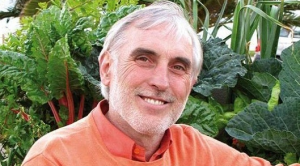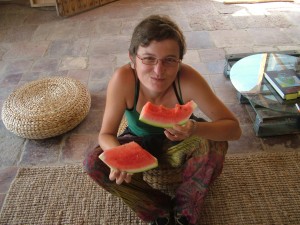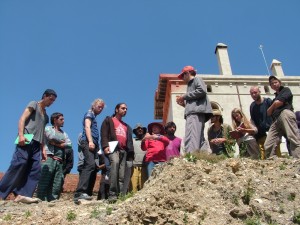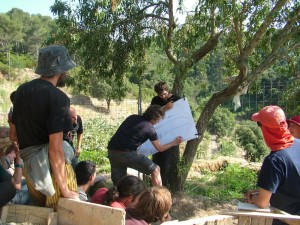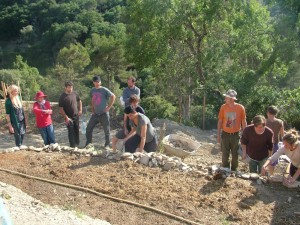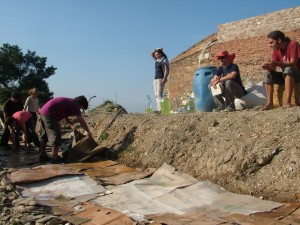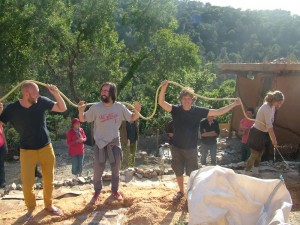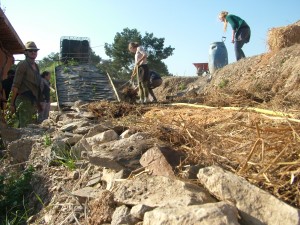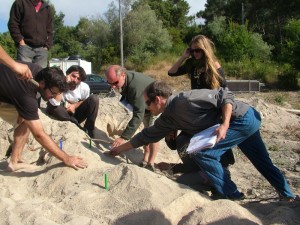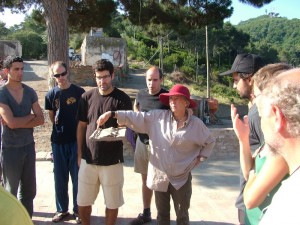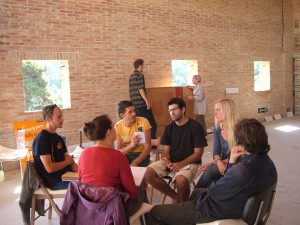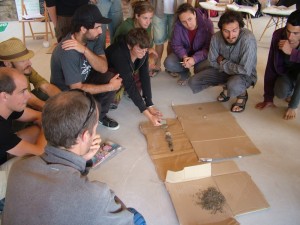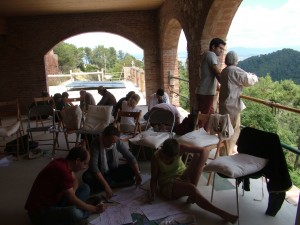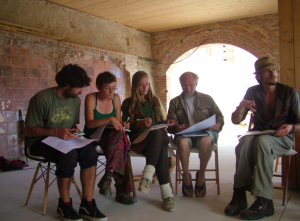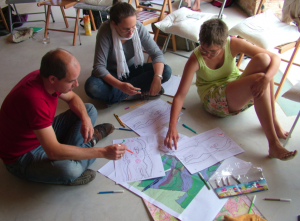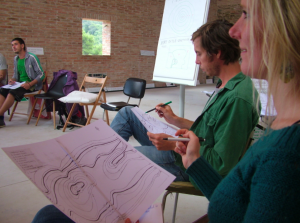SOLAR SHOWER WORKSHOP (Rodrigo Rubio)
We spend the weekend understanding how to use solar energy. In order to get heat water using solar energy and thus get a shower in summer and in winter with no active energy demand. We will cover the basics of plumbing technicians and care to create a beautiful and functional design with sustainable materials, integrating the structure and waste in our permaculture design.
Nos pasaremos el fin de semana entendiendo cómo utilizar la energía solar . Con tal de conseguir calentar agua mediante la energía solar y por tanto conseguir ducharte en verano y en invierno sin ninguna demanda energética activa. Cubriremos los fundamentos técnicos de fontanería y también del cuidado para crear un diseño bonito y funcional con materiales sostenibles, integrando la estructura y sus residuos en nuestro diseño Permacultural.

Rodrigo Rubio
Architect / Escuela Politécnica de Madrid (ETSAM), first prize at the Selfsufficient Building International Contest, and master degree in Advanced Architecture in 2006. Since then, Rodrigo Rubio has been leading several research projects at IAAC such as the Albacete Effect, the Hyperhabitat Venice Bienale, or the Solar Decathlon Europe FabLabHouse. He founded, along with Daniel Ibáñez, the MaRGeN architectural office in Madrid in 2005, inside the FreshMadrid platform, focused on landscape and selfsufficiency issues, awarded with several prizes in national and international competitions. Nowdays he is directing the Projects Office at IAAC from which the recently finished Endesa Pavilion was developed.
Arquitecto / Escuela Politécnica de Madrid (ETSAM), primer premio en el Concurso Internacional de Arquitectura Autosuficiente, y Master en Arquitectura Avanzada en el año 2006. Desde entonces, Rodrigo Rubio ha liderado varios proyectos de investigación en el IAAC, tales como el efecto de Albacete, la Hyperhabitat Bienal de Venecia o el Solar Decathlon Europe FabLabHouse. Fundó, junto con Daniel Ibáñez, la oficina Margen de arquitectura en Madrid en 2005, dentro de la plataforma FreshMadrid, dedicado a cuestiones paisaje y autosuficiencia, galardonado con varios premios en concursos nacionales e internacionales. Hoy en dia está dirigiendo la Oficina de Proyectos de IAAC de la que se desarrolló el Pabellón de Endesa acaba de terminar.
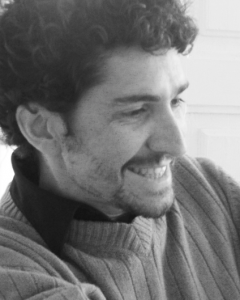
STRAWBALE WORKSHOP (Jamie Nicol)
Building with strawbales provides a rapid, cheap and insulative alternative to conventional materials. Come and join us to learn construction basics; of the importance of providing adequate ´hat and boots´ – roof and foundations – and the varied and creative possibilities of strawbale wall-raising, including the theoretical detail necessary to understand both load and non load-bearing types.
Brief summary of the subjects:
* How to build with straw bales
*Calculation of the constructive forces
*Different types of construction
*How to build a greenhouse – chicken coop
La construcción con balas de paja proporciona una alternativa rápida, barata y aislante a los materiales convencionales. Ven y únete a nosotros para aprender los pilares básicos de la construcción como la importancia de proporcionar un buen techo y cimientos. También se aprenderán las variadas y creativas posibilidades de la construcción con fardos de paja.
* Cómo construir con balas de paja
*Cálculo de las fuerzas constructivas
*Diferentes tipos de construcción
*Cómo construir un invernadero – gallinero
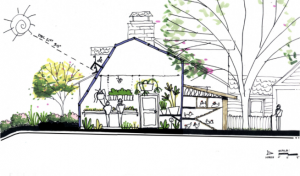
Jamie Nicol
Long time student of Permaculture, fortunate to have had great teachers Emilia Hazelip, Masanobu Fukuoka, Marc Bonfils; gardener, forest gardener, natural builder and writer.
Estudiante de Permacultura des de hace mucho tiempo, con la suerte de haber conocido y aprendido de grandes maestros como Emilia Hazelip, Masanobu Fukuoka y Marc Bonfils. Jardinero, constructor bosques comestibles y escritor.
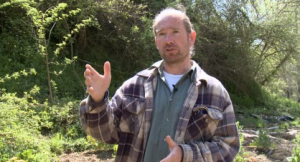
FOREST GARDEN WORKSHOP (Jamie Nicol & Ferran Masip)
This weekend will continue the work begun on December 4, 2012, coinciding with the 850th anniversary of the founding of Valldaura, when we planted 150 trees and shrubs. Forest gardening is a low-maintenance, sustainable, plant-based, food production and agroforestry system based on woodland ecosystems, incorporating fruit and nut trees, shrubs, herbs and vines and perennial vegetables which have yields directly useful to humans. Making use of companion planting, these can be intermixed to grow in a succession of layers, to build a woodland habitat.
Brief summary of the subjects:
* What is a Forest Garden and its functions – History and evolution
* The 7 layers
* Succession
* How to implement a Forest Garden
* Plant new species
* Mulch, protection and maintenance of a Forest Garden
Este fin de semana se continuará con el trabajo empezado el 4 de Diciembre de 2012, coincidiendo con el 850 aniversario de la fundación de Valldaura, día que se empezó la plantación de 150 árboles y arbustos. El trabajo práctico contará con la implementación de nuevas especies vegetales, mulch… La teoría se basará en explicar los detalles necesarios para el establecimiento de bosques comestibles en espacios forestales pequeños hasta en patios.
Materias:
* ¿Qué es un bosque comestible? – Historia y evolución
* Conocer las 7 capas
* La sucesión natural dentro de un bosque
* Cómo implementar un Bosque Comestible en tu finca
* Plantación de nuevas especies
* Mulch, protección y mantenimiento de nuestro Bosque Comestible
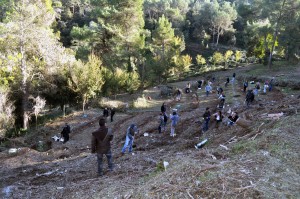
LICHT HUNTERS WORKSHOP (Alfonso Borragán)
Light Hunters is a space in which to experiment and create this illusion. Since its inception, pinhole photography has worked on these ideals, breaking the barriers that the language of photography itself has built, and opening the door to a whole new field of experimental photography. Jumping into the void with no strings attached, where play and intuition are the tools. To live is to play, and the game the key to creativity. One step back to “standby” to primitivize and re-imagine technology.
Photosynthesis is a production workshop about experimental photography and pinhole, and is mainly aimed at creatives. The workshop will develop in the context of the forest, using all means and materials that can contribute to the creation of images. In some ways it could be called vegetal ‘estenopia’ (vegetal recording devices). The workshop will experiment with natural photosensitive materials, the place and the imagination to derive the hidden images of the forest.
The workshop will be held in 10 days, divided into two parts. The first part will take place in the month of May by a 5-day intensive immersion, beginning with an investigation into the site, the materials and the content of the workshop. This will initiate discussions about potential projects. The second part will take place in the month of July, and in the same way using a 5-day intensive immersion, the realization of projects will be held through seminars, field work and workshops. The intervening months between the two phases will be devoted to the development of individual projects supported by digital tutorials.
Throughout the workshop will alternate fieldwork and theoretical and critical material, placed in artistic projections, technique and practice for enhancing the imagination and the world of ‘estenopia’. Each participant must make a device capable of generating images with the forest.

Cazadores de luz es un espacio en el que experimentar y crear a través de los límites de la fotografía. La fotografía no es sólo una herramienta para representar, es un medio lleno de magia e ilusionismo capaz de imaginar. Desde sus inicios, la fotografía pinhole ha trabajado sobre estos ideales, rompiendo las barreras que el propio lenguaje de la fotografía construía, y abriendo así las puertas a todo un nuevo campo de fotografía experimental. Un salto sin cuerdas al vacío en el que el juego y la intuición son las herramientas. Vivir es jugar, y el juego la clave de la creatividad. Una vuelta atrás, un “standby” para primitivizar e imaginar la tecnología.
Fotosintesis es un taller de producción alrededor de la fotografía experimental y pinhole. Esta principalmente dirigido a creadores. El taller se desarrolará en el contexto del bosque utilizando todos los materiales que ese medio puede aportar a la creación de imágenes. De algún modo se podría llamar estenopia vegetal. En el taller se experimentará con materiales fotosensibles naturales, el lugar y la imaginación para obtener las imágenes ocultas del bosque.
El taller se desarrollará en 10 jornadas, divididas en dos partes. La primera parte tendrá lugar en el mes de Mayo mediante una inmersión intensiva de 5 días se comenzará la investigación sobre el lugar, los materiales y el contenido del taller para empezar a discutir sobre los posibles proyectos. En la segunda parte que tendrá lugar en el mes de julio, del mismo modo mediante una inmersión intensiva de 5 días, se llevará a cabo la materialización de proyectos mediante seminarios, trabajo de campo y te taller. Los meses intermedios entre las dos fases se dedicarán a la evolución de proyectos individualmente con el apoyo tutorizado digital.
En todo el taller se alternará trabajo de campo con material teórico y crítico apoyandose en proyecciones de artistas, técnica y práctica para potenciar el imaginario del mundo estenopeico. Cada participante deberá realizar un artefacto capaz de generar imágenes con el bosque.

Alfonso Borragán
Artist. He lands on the art scene as he finds it the best way to develop his ideas. He’s only interested on works that serve as a vehicle of an experience. He creates installations that will be consumed, turning into experiences that aim to modify somehow the perception of reality, interfere on it, or simply imagine it.
He has developed and shared works in Spain, Portugal, Germany, UK, Switzerland, Norway and India. His last works have been shown in Slade School of Fine Arts, London (Aether), in Khoj Artist Association, India (Fosfofagia 03); in StudioP52, Barcelona (Documentation of 19 days living in a cave) or in Blackboxxx, Basel (Watergames).
As a teacher he has taught classes and workshops at the Swansea Metropolitan, at the Cantabria University, at the Barcelona University, in the Instituto de Arquitectura Avanzada de Cataluña (IAAC) or in the Institut d’Estudis Fotogràfics de Catalunya
Artista. Se sitúa en el mundo del arte por ser el canal que mejor le permite desarrollar sus ideas. Sólo le interesa la obra cuando esta canaliza una experiencia. Crea instalaciones que nacen para consumirse, convirtiéndose en experiencias que pretenden modificar de algún modo la percepción de la realidad, interferirla o simplemente imaginarla.
Ha desarrollado y compartido trabajos en España, Portugal, Alemania, Reino Unido, Suiza, Noruega e India. Sus últimos trabajos han podido verse en Slade School of Fine Arts, Londres (Aether); en Khoj Artist Association, India (Fosfofagia 03); en StudioP52, Barcelona (Documentation of 19 days living in a cave) o en Blackboxxx, Basel (Watergames).
Como docente ha impartido clases y talleres en la Swansea Metropolitan, en la Universidad de Cantabria, en la Universidad de Barcelona, en el Instituto de Arquitectura Avanzada de Cataluña (IAAC) o en el Institut d’Estudis Fotogràfics de Catalunya.
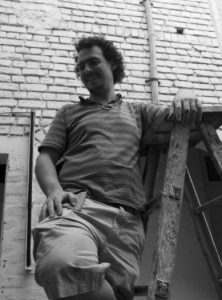
BIOINTENSIVE VEGETABLE GARDEN (Mariano Bueno)
We are very happy to announce this first weekend workshop at Valldaura with Mariano Bueno on planning, implementing and the daily maintenance of organic vegetable gardens to keep them productive.
Brief summary of the subjects:
* Basic requirements about how to design a Vegetable Garden – design and layout of spaces -
* The soil, its fertility, organic matter, compost, composting and fertilizing.
* Basic tools and management. Tillage and soil conditioning.
* Performing different cultivation terraces, high, online …
* Possible crops: vegetables, fruit and medicinal plants …
* Playback of cultivated plants: seeds, cuttings, layering, sowing, transplanting …
* Combined crops and rotations.
* Any problems (diseases, pests, weeds ..) methods of prevention and control.
* Practice in seed sowing and transplantation and terraces.
* Irrigation techniques and installation of drip irrigation system.
* Protection and maintenance of the garden and crops.
* Calendars cosmic influences culture and in plant development.
* The monthly garden, grown in the four seasons
Curso presencial donde aprender desde las bases, la planificación, la realización, la gestión del día a día y el mantenimiento de huertos ecológicos, productivos y de autoconsumo.
Materias:
* Requisitos básicos y planificación del huerto – diseño y distribución de los espacios –
* La tierra, la fertilidad de la tierra de cultivo, materia orgánica, compost, compostaje y abonado.
* Herramientas básicas y su manejo. Laboreo y acondicionamiento de la tierra.
* Realización de diferentes bancales de cultivo, elevados, en línea…
* Posibilidades de cultivo: hortalizas, frutales, plantas condimentarías y medicinales…
* Reproducción de las plantas cultivadas: semillas, esquejes, acodos; siembras, trasplantes…
* Cultivos asociados y rotaciones.
* Los eventuales problemas (enfermedades, parásitos, hierbas adventicias:..) métodos de prevención y control.
* Prácticas de siembra y trasplante en semilleros y bancales.
* Técnicas de riego e instalación de sistema de riego localizado.
* Acolchados, protección y mantenimiento del huerto y de los cultivos.
* Calendarios de cultivo e influencias cósmicas en el desarrollo vegetal.
* El huerto mes a mes, cultivar en las cuatro estaciones
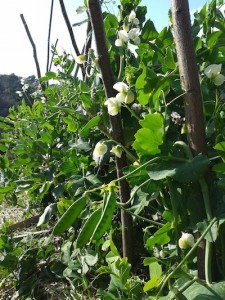
Mariano Bueno
Expert, pioneer and great teacher of Ecological Agriculture, Geobiology, Bioconstruction and healthier life choices in Spain and Latin America. His personal and professional career has enabled multidisciplinary cover areas such as Agriculture, Ecology, Biology, Physics, Architecture, Psychology, Healthy Food and Natural Health.
Experto, pionero y gran divulgador de la Agricultura Ecológica, la Geobiología, la Bioconstrucción y las alternativas de vida mas saludables en España y en Latinoamérica. Su trayectoria personal y profesional le ha permitido abarcar áreas tan multidisciplinares como la Agricultura, la Ecología, la Biología, la Física, la Arquitectura, la Psicología, la Alimentación Sana o la Salud Natural.
